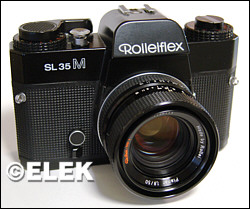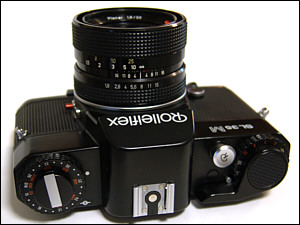Rolleiflex SL 35 M

|
|
|
| Style, film format | 35mm interchangeable lens single-lens reflex system |
|
|
|
| Lens, shutter | Coated f/1.8 50mm Planar, horizontal cloth shutter |
|
|
|
| Photo quality | Excellent |
|
|
|
| Ergonomics | Large camera with a stiff film advance. |
|
|
|
With production of its 35mm single-reflex cameras now firmly entrenched in Singapore, Rollei unleashed on the photographic world an entirely new camera.
The first cameras (SL 35 and SL 350), reworked Voigtlander models, seemed rather primitive compared with its Japanese competitors. Canon had brought forth the AE-1 with its advanced all-electronic shutter, LEDs in the viewfinder, automatic exposure and small lightweight body.
The Rollei/Voigtlander cameras must have seemed rather dated with its match-needle closed-aperture metering, all-manual shutter and rather dated design.
The SL 35 M was a departure in functionality, as well as visual styling. Although never stated, the SL 35 M was a descendant of the Voigtlander Icarex single-lens reflex camera.
When Zeiss Ikon absorbed Voigtlander, the Icarex became the Zeiss Ikon SL 706. After Zeiss Ikon shut down, Voigtlander's 35mm cameras became part of the Rollei operation, and the SL 706 became the SL 35 M with a sister Voigtlander model.
The sharply angled prism housing of the SL 35 was replaced by a flat-top with gently curved sides with the Rolleiflex name bodly engraved on the front. I find it to be quite attractive.
Whereas the SL 35 was a somewhat sleek camera, the same can't be said of the SL 35 M. It's large. It's very large.Leather was out, as far as covering the body was concerned. The SL 35 M now had a diamond grip, hard rubber covering. About the only vestige to the past was the horizontally running cloth shutter.
The SL 35 M (finally) featured open-aperture metering, and the photographer could see the selected aperture. However, the system relied on a CdS (cadmium sulfide) sensor, and as we know, they aren't always quick to react to rapid changes in lighting, such as moving the point from a brightly lit area to a subject in the shade.
One improvement: The brightness and clarity of the viewfinder is a huge improvement over the SL 35 and superior to what you'll find in most other SLRs then or since. In addition, the central spot is divided by a diagonal bar. In all, it's an excellent viewfinder that remains very usable in low light when many viewfinders in other cameras become very difficult to see.
The traditional SLR shutter speed dial was eliminated in favor of a large oversized dial at the base of the film advance. The dial has no start and end points, so you can move quickly from B to 1/1000, if needed. There are two flash synch speeds -- marked with icons for bulb flash and electronic flash. The self-timer lever is pushed up, and doing so reveals its small release button.
A single 625 cell powers only the meter. If the battery dies, you can keep shooting.

The non-ratcheted film advance requires a single throw with a firm push at the end to tension the shutter. Moving the advance to the stand-off position releases a small pin, which turns the meter on. Pushing it flush with the back of the camera turns the meter off.
Film speeds are set on the dial that surrounds the rewind crank. Pulling up on the crank releases the back catch. There is no so-called safety, so don't pull upward unless you mean to open the back. There is always the possibility of it catching on your bag or clothing, so be mindful of this.
Like many German cameras, there are no foam seals. The back and body mate in a labyrinth design that properly blocks light. Japanese camera makers would have done well to adopt this style instead of cutting corners.
The mirror box is simple enough. The mirror cushion is a hard rubber. There is no provision to lock the mirror in the up position. The all-metal lens mount is surrounded by flash-synch sockets, the lens release button (red) and a depth of field preview (chrome).
My only gripe about the camera is the height of the shutter release.
It should have been taller because the film advance stands quite high because
of the shutter speed dial. To compensate, I've added a so-called soft-release,
which you can see in the photo. It has the nice engraved Rollei "R."
